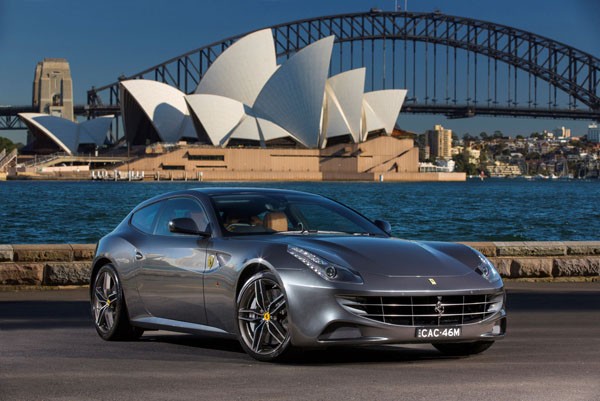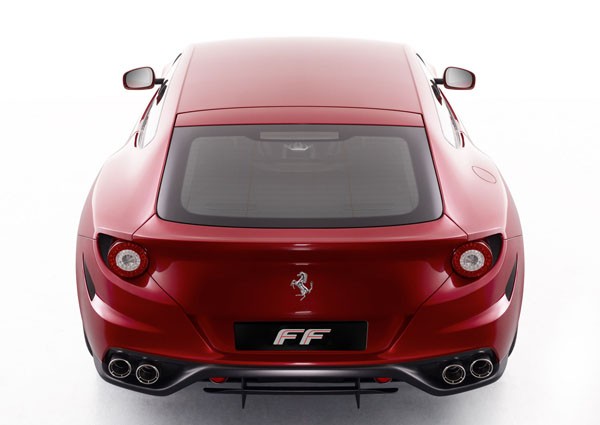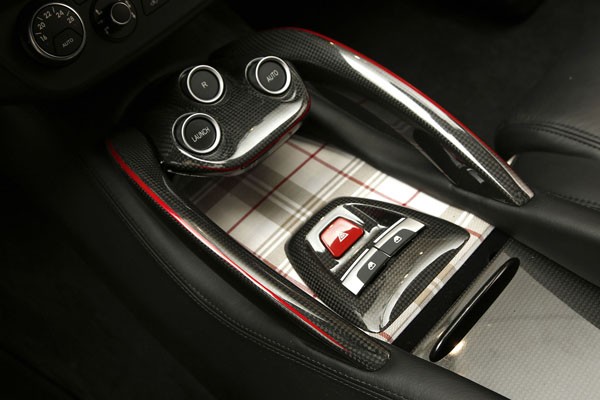Ferrari created a storm when it unveiled the FF at the 2011 Geneva Motor Show. I know, because I were there – but couldn’t see the FF until half an hour after the covers were removed. That’s how long it took for the astonished crowd to clear. Keep in mind we are talking about a bunch of cynical seen-it-all-before car journos and you will really come to understand the sensation the FF created.
Ferrari FF stands for Four-seat, Four-wheel-drive. It’s a big car aimed at the grand touring buyer. ‘GT’, which is what grand touring initially meant, means travelling around Europe at high speeds in plenty of style.
STYLING
Interestingly, Ferrari FF can be classed as a sort of station wagon, or shooting-brake to use term from the past that’s recently been revived. We’ve even heard some say the FF could be described as the first ever Ferrari SUV. The latter isn’t as silly as it sound as even companies like Bentley are joining the current SUV craze, so why not Ferrari?
Inside, it’s pure Ferrari with quality materials, very Italian styling, electronic dials with a huge tacho taking centre position, and the most complex steering wheel this side of an F1 Ferrari.
ENGINE / TRANSMISSION
What’s under the FF’s bonnet and what’s it like to drive? The first bit is easy, there’s a V12 displacing 6.3 litres and putting out 650 horsepower. This drives all four wheels through a relatively simple system, tagged 4RM, that takes power from the back of the engine to the back wheels, and from the front of the engine to the front wheels. This is the first time a Ferrari has had all-wheel-drive.
A double-clutch seven-speed auto sits between the rear wheels. The gearbox at the front has just two speeds; the FF only uses all-wheel-drive in the first four gears. In fifth, sixth and seventh it’s strictly rear-wheel-drive. (Told you it was simple! There are several good explanations on the internet if you really want to get into finer details.)
DRIVING
What a sensational vehicle. From the moment you punch the big-red Start button on the steering wheel and the V12 blasts its way into life with a loud shriek you know something special is coming.
Ferrari’s patented ‘manettino dial’ on the steering wheel provides multiple driving modes: Snow and Wet are self explanatory and only used when weather conditions are pretty drastic; Comfort is a nice compromise for day-to-day commuting.
Then we get onto the serious stuff: Sport lets you have a great deal of fun, but the Ferrari steps in to help you out of trouble if you really stuff up. ESC Off means you’re on your own and is probably best left purely for track days.
The engine note is to die for, it’s not quite F1 in its sound, but has a touch of the scream you used to get from F1 Ferraris before the latest too-quiet ‘power units’ were introduced. Get the tacho up to the top end of the dial – it’s redlined at 8000 – and its angry snarl is sure to bring a smile to your face.
Flooring the throttle with the Ferrari stationary causes it to give a big wriggle at the rear as the tyres struggle with the huge power suddenly thrown at them. The fronts grip within a few tenths of a second and take all of the fun out of it. Just 3.8 seconds later you’re over the speed limit just about everywhere in Australia with exception of the Northern Territory. Love it!
Transmission response is all but instantaneous, with the double-clutch taking only milliseconds to get the engine into the meat of the power band. Downchanges don’t have quite as much rev-matching ‘blip’ as we like; they’re perhaps too German in their precision, rather than taking the Italian ‘let’s have another few hundred revs just for the fun of it’ we would like.
Not having a chance to use racetrack setting during our too short two days with the FF was a pain. Suffice to say we loved the fast acting steering that lets you can keep your hands fixed on the wheel in all but very tight bends. And the amount of grip generated on our favourite mountain roads was everything we expected.
The brakes are huge, as you would expect on a car capable of 335 km/h and push you forward against the seat belts as the FF reduces speed astonishingly quickly.
Ride comfort? Hardly a priority in a supercar, but you do feel the dips and bumps as they pass under the big tyres. In the high-performance modes you can push another steering wheel button marked – believe it or not – ‘bumpy road’. This tones things down reasonably well so you can continue to enjoy life.
While Ferrari FF certainly isn’t an off-road SUV you might like to check out YouTube to witness an FF drifting its way around snowdrifts and similar rugged terrain. The four-wheel-drive system certainly does its stuff.
Though one of the ‘Fs’ in the big Ferraris name stands for four seats the pair in the back are barely large enough for adults. Then again, the FF is more than a squeezy 2+2. If you want to get serious about carrying four frequently you might have to find the extra money for an Alfa Romeo or a Maserati Quattroporte as a second car to support the $624,646 FF.
AT A GLANCE
MODEL RANGE
Ferrari FF 6.2-litre two-door coupe: $624,646
Note: This price does not include dealer or government charges. Contact your local Ferrari dealer for the drive-away price.
SPECIFICATIONS (Ferrari FF 6.2-litre two-door coupe)
ENGINE:
Capacity: 6.262 litres
Configuration: V12
Head Design: DOHC, four valves per cylinder
Compression Ratio: 12.3:1
Bore/Stroke: 94.0 mm x 75.2 mm
Maximum Power: 486 kW @ 8000 rpm
Maximum Torque: 683 Nm @ 6000 rpm
DRIVELINE:
Driven Wheels: AWD
Manual Transmission: Not offered
Automatic Transmission: Seven-speed dual clutch
Final Drive Ratio: Not available
DIMENSIONS, WEIGHT AND CAPACITIES:
Length: 4907 mm
Wheelbase: 2990 mm
Width: 1953 mm
Height: 1379 mm
Turning Circle: Not supplied
Kerb Mass: 1880 kg
Fuel Tank Capacity: 91 litres
Towing Ability: Not recommended for towing
Boot Capacity: 450 litres
SUSPENSION AND BRAKES:
Front Suspension: Third generation of magnetorheological suspension control
Rear Suspension: Third generation of magnetorheological suspension control
Front Brakes: Ventilated disc
Rear Brakes: Ventilated disc
PERFORMANCE
0-100 km/h Acceleration: 3.7 seconds
FUEL CONSUMPTION:
Type: Petrol 98RON
Combined Cycle (Euro): 15.4 L/100 km
GREEN VEHICLE GUIDE RATINGS:
Greenhouse Rating: Not rated
Air Pollution Rating: Not rated
STANDARD WARRANTY:
Three years/unlimited km













